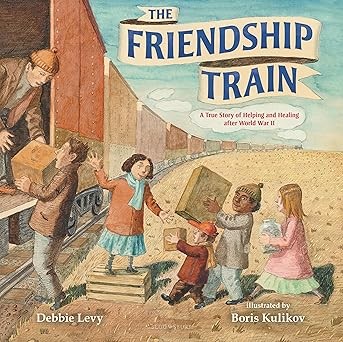
This remarkable documentary style biography received the Sibert Medal (award for best nonfiction). The story of this remarkable woman begins when she was 13 years old. Maria spent her days—this was in the 1600s—painting butterflies. But she wanted to know more and do more. She wanted to understand their mysterious lives at a time when no one did. She wanted to know if there was a connection between the caterpillars and butterflies she was painting. Without formal education and knowing that she could be branded as a witch for her interest in insects, Maria took on the role of artist, adventurer, and scientist. Her story masterfully painted by Joyce Sidman (a Newbery honor-winning author). The biographical information itself is intriguing. The structure and features of this book are amazing. Excerpts of this book could be used for multiple close reading lessons. In addition to the biographical text there are inserts of setting that lend themselves to a fuller understanding of the1600s. Readers learn about copper engraving, women workers in those times, science before photography, and much more. Every part of this book begs to be explored. It is, “a marvel of a book, just like the subject. . . and as a caterpillar emerges out of its chrysalis, this book brings Merian out of the darkness and into the light.” The companion picture book, The Bug Girl by Sarah Marsh, might make a good read-aloud to build background knowledge and to spark interest in this remarkable contributor to the knowledge we have now about the world of insects and plants.
About the Author
Joyce Sidman is America’s nature poet. If you look you may find some of her poetry right there in your school or classroom library. With her award-winning body of work, she was awarded NCTE’s Award for Excellence in Poetry for Children. Her website, joycesidman.com, opens with her words, “My world is full for frogs, poetry, light, and color—welcome!” Students might want to explore the books shown on her website and choose some for the classroom. My favorite book of her poetry is Swirl by Swirl. Students could spend a quality time just getting to know each book because one click of each will give an excerpt, a brief synopsis, and blurbs from others. What a great reading lesson this could be. The Poetry Now link gives many fascinating forms for writing poetry that most teachers and students are unfamiliar with. There are also interviews and articles students may want to access to learn about Sidman, the things she has learned from nature, and her writing. Example—Trees do different tasks at night than they do in the day. I would highly recommend that teachers and students engage in an author study during the Living Things Pathways theme. This is one intriguing woman who can teach students so much from her website. Along with the author study I’d have students use some of the poetry forms to compose poems about living things.
Pathways: Living Things, Yesterday, Heroes
Reviewed by Krystal Bishop, EdD
Professor of Education
Southern Adventist University


Author: Debbie Levy